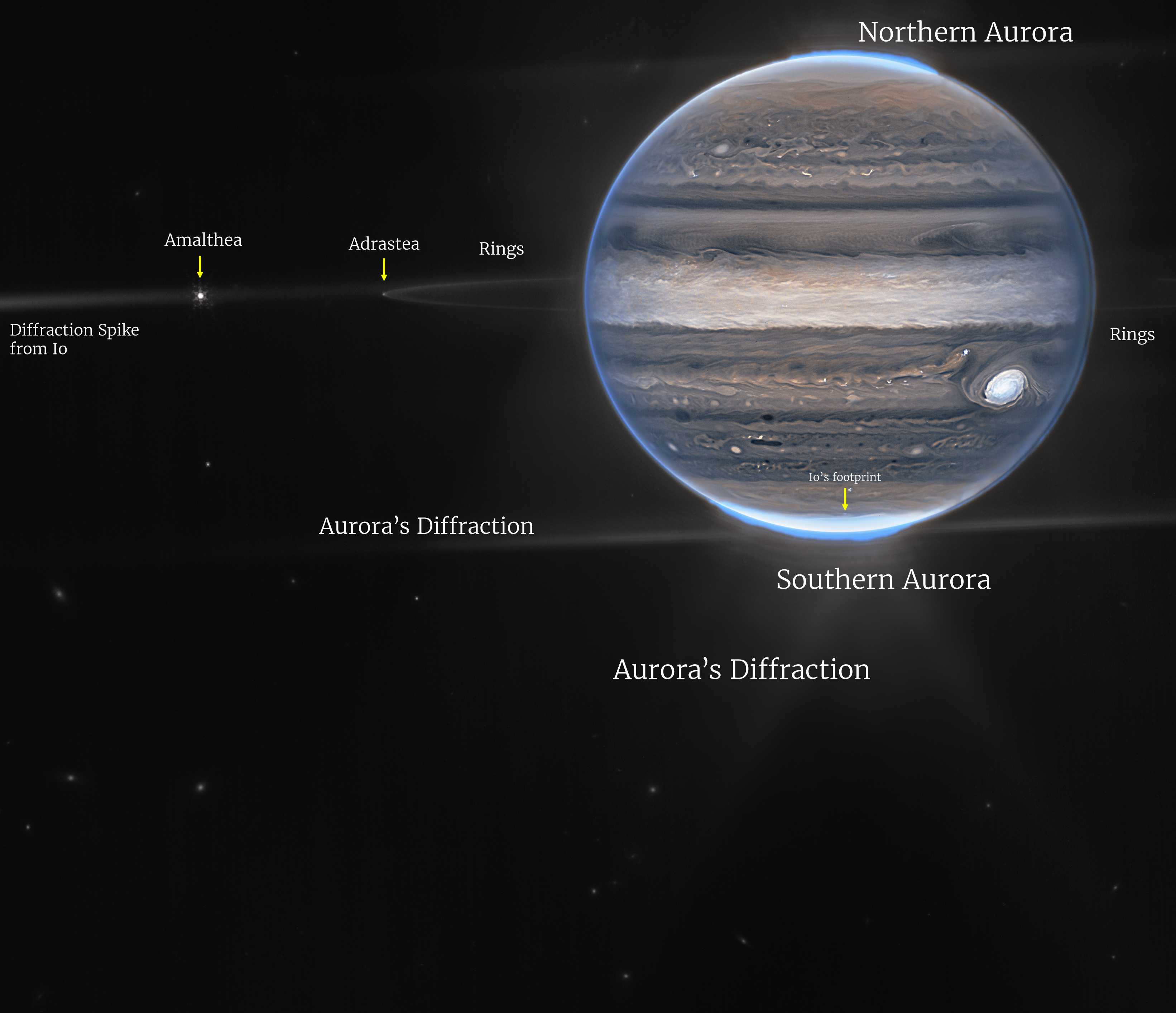Webb Telescope
In a recent blog, we looked at some of my picks of images from the Webb Telescope.
Now we complete the set with the rest of my Webb Telescope Top Ten.
6. Jupiter
We’ll start in our Solar System with Webb’s image of the largest planet Jupiter.

Jupiter. Credit: NASA, ESA, CSA, Jupiter ERS Team; image processing by Judy Schmidt.
This Webb image of Jupiter was taken by NIRcam, the Near-Infrared camera.
It shows the horizontal cloud bands and zones with turbulent storms.
The largest storm is the Great Red Spot, which shows up white on the image.
White shows high altitude features that reflect a lot of sunlight.
At the poles we can see Jupiter’s auroras, like our Northern and Southern Lights on Earth.

Jupiter: Credit: NASA, ESA, CSA, Jupiter ERS Team;
image processing by Ricardo Hueso (UPV/EHU) and Judy Schmidt.
The second webb image, again from NIRCam, takes a step back.
Now we can see two of Jupiter’s smaller moons, Amalthea and Adrastea.
Between the moons and the planet Jupiter’s faint dusty ring becomes visible.
7. Crab Nebula

Left: Hubble Space Telescope. Right: Webb Space Telescope.
Hubble Image: NASA, ESA, J. Hester, A. Loll (Arizona State University);
Webb Image: NASA, ESA, CSA, STScI, T. Temim (Princeton University)
The Crab Nebula is the remains of a supernova, an exploded star.
It lies 6,500 light years away.
The star explosion was observed by the Chinese and Arabs in the year 1054.
It’s designation is SN 1054 but is better known by its Messier Catalogue number, M1.
The general shape of the expanding gas cloud is similar from both space telescopes.
Webb’s Infrared camera shows more subtle details.
Fluffy gas filaments show up as red-orange.
Near the centre, yellow and green light comes from dust grains.
At that centre is a pulsar, a fast-rotating neutron star.
This is the collapsed core of the star, crushed by gravity during the supernova explosion.
8. Centre of the Milky Way

Milky Way core: NASA, ESA, CSA, STScI, and S. Crowe (University of Virginia).
In this image, Webb’s NIRCam looks at the centre of our Milky Way galaxy.
It’s 25,000 light years away and about 500,000 stars show up in the image.
Among them are protostars, stars that are still forming.
They produce outflows of hot gas.

Image features: NASA, ESA, CSA, STScI, Samuel Crowe (UVA)
The annoted image shows a cluster of protostars and dark clouds surrounding others.
In all, Webb shows that the centre of our galaxy is an extreme envioronment.
9. Spiral Galaxies

19 Spirals: NASA / ESA
Webb has imaged 19 spiral galaxies in unprecedented detail.
They are known by catalogue numbers for deep space objects.
NGC is the New General Catalogue, IC is the Index Catalogue.
The images show stars, gas and dust in these huge star cities.
We can follow the spirals of stars inwards to the centre.
There lie old star clusters and a supermassive black hole.
The spherical rings in some of the images are thought to be the remains of exploded stars.
The evidence suggests that galaxies grow from the inside out.
Stars are first made at the galaxy centre.
Then star formation spreads out, spiralling out from the middle.
Stars further out are younger. The oldest stars are at the galaxy’s core.
10. A Spiral among thousands

Hercules Cluster of galaxies: NASA / ESA / Webb
My final image epitomises one of the main science goals of the Webb Space telescope.
It shows galaxies in the Hercules galaxy cluster.
In the foreground is a splendid spiral, one of thousands in the cluster.
It is around one billion light years away.
As Webb peers into the distance, it is effectively looking back in time.
It will see how galaxies form and evolve.
It will shed more light on how our universe was shaped.

And, along the way, it will give us wonderful images of that amazing universe.
The Webb Space Telescope is a remarkable astronomical explorer.

The author: Dennis Ashton is a Fellow of the Royal Astronomical Society and a Wonderdome presenter.
In September 2024, Dennis received the Special Contribution Award from the British Association of Planetaria.
Would you like to hear more Astronomy news?
Do you want to to find out about our upcoming public events?
Follow WonderDome Portable Planetarium on Twitter and Facebook or go to our web site wonderdome.co.uk

